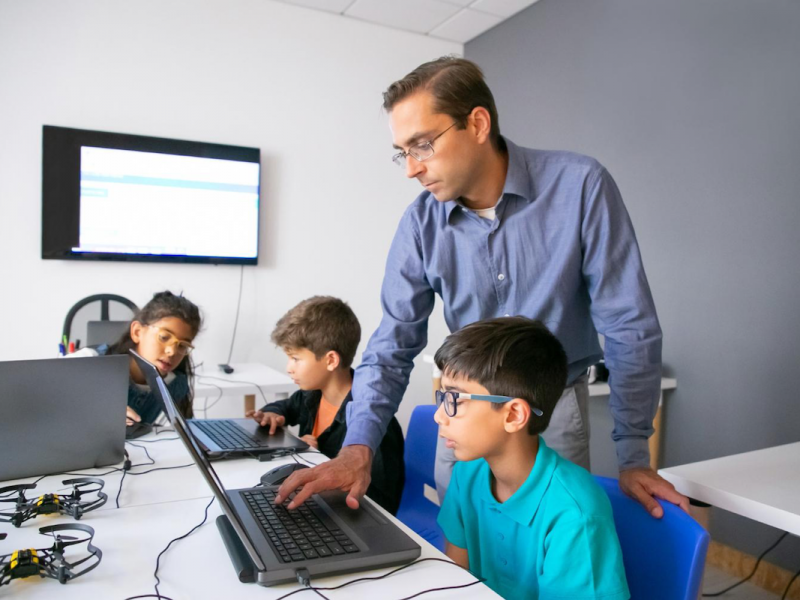While technology adoption in learning methodology has been rapid for middle and high school students, the teaching methodology for kindergarten and younger children, in the age group of 3 to 6 years of age, continues to follow traditional methods.
In case of pre-school and early education, the need for a real, interactive, and holistic learning environment is crucial for children in the age group of 3-6 years of age as this is when most children develop socio-emotional skills, and thus peer to peer and teacher interaction is crucial. Additionally, a guided learning environment where a child is encouraged to explore and feels safe to take risks, is vital to aid early development. However, it was so far believed that this essentially developmental learning environment cannot be offered by virtual classrooms. Additionally, challenges like fear of exposure to extensive screen time, which could be harmful for the mental and physical development of a child, as well as lack of quality content, have so far been holding back the adoption of ed-tech for pre-schoolers.Ed tech for early learning among young children
With covid though, the need for creating innovative solutions that can address the above challenges, has become important. The key aspects that need to be considered when driving technology adoption for early learning, may include:
- Specialised, supportive curriculum that is designed to increase access to learning opportunities
- Enhance supportive participation of parents and interaction with peers
- Enhance engagement between parents and teachers/ schools
LISTED HERE ARE SOME TOOLS THAT CAN BE CONSIDERED:
Edutainment ‘play dates’ with parents: Technology enabled, interactive games offer an opportunity for parent engagement and enable enhanced learning capacity among young children, in a controlled and supervised environment. From dedicated apps and customised devices to well-planned edutainment modules, the content for ‘play dates’ can offer fun edutainment content around languages, basic maths, and offers an introduction of the world around, and can go a long way in helping children to understand, learn and retain effectively.
Augmented Reality (AR) based interactive edutainment: Experiments leveraging emerging technologies like AR, for early learning, have been found beneficial across various areas of child development. From creating ‘educational magic toys’ to building models that help simplify basics of human anatomy, geography and mathematical problem solving, are already in use. AR led assisted learning tools are beneficial to help children develop spatial thinking, cognitive understanding, build strong observational skills, and thus understand and absorb knowledge faster.
Early STEM learning tools: Similar to AR, Artificial Intelligence, or AI based robotic tools are becoming popular among students, parents, and schools, as an efficient form of learning aid. Early learning tools help student understand and apply the basics of Science, Technology, Engineering, and Mathematics (STEM) via Robotics, and are already made available to students through robotics or STEM labs. These tools, which may also involve building a basic robot from scratch and learning coding, encourage logical reasoning and develop a problem solving approach among children by driving them to think out of the box.
Integrate art and education: Fun and creativity have always been the best tools to assist learning among young children. While emerging technology enabled tools have been used to build the logical and cognitive capabilities, using creative tools like music and art based educational programs for learning, helps in developing the social, emotional, and interpersonal abilities for children. The activities that leverage art form for learning, essentially focus on a child’s ability to function as a group, learn the art of self-expression, interpersonal skills, and learn language, phonetics, motor movements, and physical expression etc.
Supportive framework for parents and teachers: Apart from learning aids, technology can also be a great enabler for creating a supportive and real-time engagement platform for parents and teachers. Parents of young children have many things on their minds and are more involved in their child’s learning journey. A single window school communication platform that offers real engagement, announcements, and progress updates, can go a long way in not only helping create a smooth communication but also a supportive ecosystem for students.
Audio books Voice enabled assisted learning: Story telling has always been one of the earliest forms of teaching techniques. Assisted learning via voice tech devices like Alexa, Google Home etc., when explored as early learning tools, can benefit greatly and help children in learning diction, voices and accents, comprehension, and develop vocabulary and oratory capabilities.
Interactive game and e-books: With the advent of smart devices like iPads, tablets, smartphones and e-books etc., learning can be made fun and interactive. Customised/ supervised gadgets, with voice and interactive games based content can help gain learning outcomes across subjects like mathematics, history, general knowledge, and languages. Apart from being engaging, entertaining and interactive, it also allows self-paced learning with parent participation.
The above mentioned pointers about digital learning tools for early childhood, offer a balanced education and entertainment value to children and call for active participation by parents and teachers, ensuring healthy screen time for children. With the overall pace of education moving towards agile, paperless learning experiences driven by the best of emerging technology, it is only a matter of time before technology enabled, age appropriate, and guided assisted tools for early learning, will be a reality.
This article is written by Ashish Chaturvedi, Founder, SchoolDiary and was first published in ‘IndiaToday’ on Oct 30,2020



One thought on “Ed tech for early learning among young children”